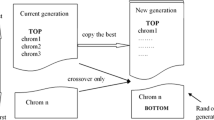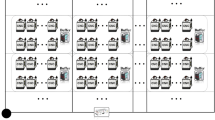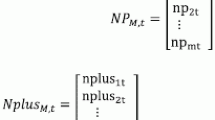Abstract
Our design for AGV system integrates machine assignment, machine layout, transfer station setting and loop arrangement and other issues and become a complex combinatorial design problem in the manufacturing. In previous studies, researches tried to address these issues in several steps, which may separate the coupling relations in these issues. We herein propose a co-evolutionary methodology to design one complex AGV system that includes two tandem AGV systems (workshops) synchronously. Our method gives an overall consideration for the aforementioned issues, which overcomes the defects of solving these issues in sequence by the previous studies. Moreover, the corresponding mathematical model is built for this design of complex AGV system. The proposed co-evolutionary methodology has two optimization parts, part A and part B for optimizing two workshops synchronously. Workshop 1 divides the four aforementioned issues into two classes, machine assignment and loop layout. The machines are assigned to different loops, and the exact layout of machines is optimized in each loop; meanwhile, the transfer station is set and loops are arranged in workshop. Workshop 1 has a re-optimization step using part B. For another, workshop 2 only optimizes the machine layout by part B. An improved fuzzy IWO (f-IWO) is proposed to execute the optimization for parts A and B in the methodology. Therein, a synthetic evolution mechanism with a fuzzy number has efficiently improved the quality of f-IWO. At last, a numerical experiment of design for complex AGV system validates the co-evolutionary methodology and f-IWO comparing to the contrastive methods.







Similar content being viewed by others
References
Bozer YA, Srinivasan MM (1989) Tandem configurations for AGV systems offer simplicity and flexibility. Ind Eng 21(2):23–27
Bozer YA, Srinivasan MM (1991) Tandem configurations for Automated Guided Vehicle systems and the analysis of single vehicle loops. IIE Trans (Institute of Industrial Engineers) 23(1):72–82
Aarab A, Chetto H, Radouane L (1999) Flow path design for AGV systems. Stud Inform Control 8(2):97–106
Jia H, Cheng F (2012) A programming method of vehicle dispatch for service centre. In: 2nd International Conference on Frontiers of Manufacturing and Design Science, ICFMD 2011, December 11, 2011–December 13, 2011, Taichung, Taiwan, 2012. Applied Mechanics and Materials. Trans Tech Publications, pp 662–666. doi:10.4028/www.scientific.net/AMM.121-126.662
Rahimi-Vahed A, Crainic TG, Gendreau M, Rei W (2013) A path relinking algorithm for a multi-depot periodic vehicle routing problem. J Heuristics 19(3):497–524. doi:10.1007/s10732-013-9221-2
Bozer YA, Srinivasan MM (1992) Tandem AGV systems: a partitioning algorithm and performance comparison with conventional AGV systems. Eur J Oper Res 63(2):173–191. doi:10.1016/0377-2217(92)90024-4
Laporte G, Farahani RZ, Miandoabchi E (2006) Designing an efficient method for tandem AGV network design problem using tabu search. Appl Math Comput 183(2):1410–1421
Tavakkoli-Moghaddam R, Aryanezhad M, Kazemipoor H, Salehipour A (2008) Partitioning machines in tandem AGV systems based on “balanced flow strategy” by simulated annealing. Int J Adv Manuf Technol 38(3–4):355–366
Saravanan M, Kumar SG (2013) Different approaches for the loop layout problems: a review. Int J Adv Manuf Technol 69(9–12):2513–2529. doi:10.1007/s00170-013-5133-4
Nearchou AC (2006) Meta-heuristics from nature for the loop layout design problem. Int J Prod Econ 101(2):312–328. doi:10.1016/j.ijpe.2005.02.001
Kumar RMS, Asokan P, Kumanan S (2008) Design of loop layout in flexible manufacturing system using non-traditional optimization technique. Int J Adv Manuf Technol 38(5–6):594–599. doi:10.1007/s00170-007-1032-x
El-Baz MA (2004) A genetic algorithm for facility layout problems of different manufacturing environments. Comput Ind Eng 47(2–3):233–246. doi:10.1016/j.cie.2004.07.001
Bozer YA, Lee C-G (2004) Using existing workstations as transfer stations in tandem AGV systems. J Manuf Syst 23(3):229–241
Ho Y-C, Liao T-W (2009) Zone design and control for vehicle collision prevention and load balancing in a zone control AGV system. Comput Ind Eng 56(1):417–432. doi:10.1016/j.cie.2008.07.007
Hsieh L-F, Sha D (1996) A design process for tandem automated guided vehicle systems: the concurrent design of machine layout and guided vehicle routes in tandem automated guided vehicle systems. Integr Manuf Syst 7(6):30–38
Rezapour S, Zanjirani-Farahani R, Miandoabchi E (2011) A machine-to-loop assignment and layout design methodology for tandem AGV systems with single-load vehicles. Int J Prod Res 49(12):3605–3633
Kusiak A, Heragu SS (1987) The facility layout problem. Eur J Oper Res 29(3):229–251. doi:10.1016/0377-2217(87)90238-4
Mehrabian AR, Lucas C (2006) A novel numerical optimization algorithm inspired from weed colonization. Ecol Inform 1(4):355–366. doi:10.1016/j.ecoinf.2006.07.003
Yanjun S, Luyang H, Xiaojun Z (2015) Solving workshop layout by hybridizing invasive weed optimization with simulated annealing. In: 2015 IEEE 19th international conference on computer-supported cooperative work in design. doi:10.1109/cscwd.2015.7231007
Hou LY, Shi YJ, Zheng XJ (2014) Hybridizing invasive weed optimization and simulated annealing algorithm for high-dimensional function optimization. In: 4th International conference on intelligent system and applied material, GSAM 2014, August 23, 2014–August 24, 2014, Taiyuan, China, 2014. Advanced Materials Research. Trans Tech Publications Ltd, pp 1436–1439. doi:10.4028/www.scientific.net/AMR.1049-1050.1436
Tansel BC, Bilen C (1998) Move based heuristics for the unidirectional loop network layout problem. Eur J Oper Res 108(1):36–48. doi:10.1016/s0377-2217(97)00062-3
Peng Y-G, Luo X-P, Wei W (2009) New fuzzy adaptive simulated annealing genetic algorithm. Control Decis 24(6):843–848 (853)
Wang C, Ghenniwa HH, Shen W (2008) Distributed scheduling for reactive maintenance of complex systems. IEEE Trans Syst Man Cybern Part C Appl Rev 38(2):269–273. doi:10.1109/tsmcc.2007.913916
Alavidoost MH, Tarimoradi M, Zarandi MHF (2015) Fuzzy adaptive genetic algorithm for multi-objective assembly line balancing problems. Appl Soft Comput 34:655–677. doi:10.1016/j.asoc.2015.06.001
Neshat M (2013) FAIPSO: fuzzy adaptive informed particle swarm optimization. Neural Comput Appl 23:S95–S116. doi:10.1007/s00521-012-1256-z
Acknowledgments
This work was supported by National Natural Science Foundation of China (No. 61304206) and the Program of Liaoning Science and Research (No. L2013460).
Author information
Authors and Affiliations
Corresponding author
Rights and permissions
About this article
Cite this article
Liu, Z., Hou, L., Shi, Y. et al. A co-evolutionary design methodology for complex AGV system. Neural Comput & Applic 29, 959–974 (2018). https://doi.org/10.1007/s00521-016-2495-1
Received:
Accepted:
Published:
Issue Date:
DOI: https://doi.org/10.1007/s00521-016-2495-1




